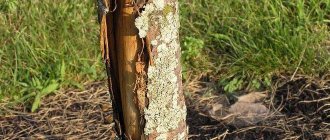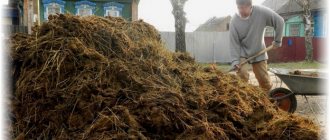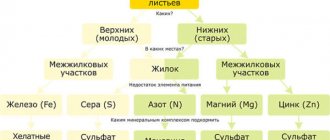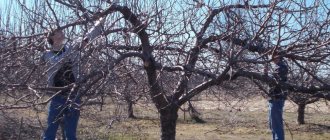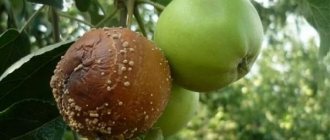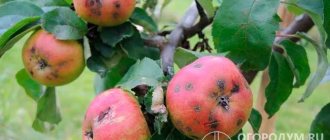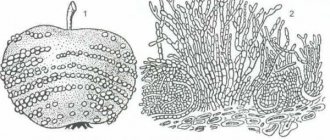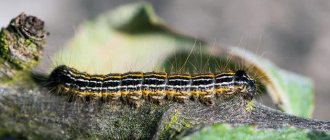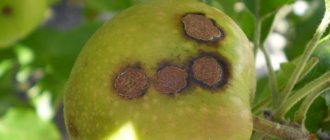Cracks on apple trees should alert the gardener! If you do not start fighting them in time, then not only the harvest may be reduced, but the entire tree may die.
The disease can spread to other fruit trees and in a short time affect almost the entire garden, causing serious damage .
From this article you will learn why the bark on apple trees bursts and how to prevent cracks from appearing on the trunk of your tree and what to do with them if they have already appeared.
If the bark cracks and...
Gets wet
The reasons that lead to wetting and cracking of the apple tree bark can be different.
The most common cause may be improper tree pruning , poor treatment and disinfection of wounds.
Wood rotting can begin due to water, microbes, viruses or fungi entering the cut site from the air.
Turns black
If the trunk of an apple tree cracks and turns black, this means that the tree has contracted the most terrible disease called black cancer .
In this case, the bark of the tree peels off and falls off, exposing the black wood.
The disease spreads to the branches and crown.
The disease destroys the tree within 3-4 years. If the disease is not detected at the very beginning of development, then it will no longer be possible to save the tree.
Peels off
Cracks and peeling of the bark can be caused by a number of reasons. For example, due to sharp changes in day and night temperatures, the bark of a tree loses its elasticity and longitudinal cracks appear.
And severe frosts, sunburn or fungal diseases can lead to more dangerous transverse cracking , which can lead to the death of the tree.
The bark bursts and the fruits dry out
If the bark of an apple tree bursts, then due to a lack of nutrients, the fruits on it may dry out, since if the bark is significantly damaged, beneficial substances from the soil do not reach the fruits.
Such wounds can appear on the tree as a result of poor-quality pruning , as well as freezing in severe winter conditions in low-winter-hardy varieties.
Yellow lichen and peeling bark
The older the apple tree, the greater its risk of developing lichen .
As a rule, it appears on the trunk and branches at high humidity and low temperature.
The lichen is white to yellow in color and spreads very quickly.
fungal diseases may appear on the tree , which lead to decomposition of the bark.
Apple tree bark diseases, their prevention and treatment
Bark diseases are most often caused by various fungi, less often by bacteria. Pathogens penetrate the bark through cracks, which can form as a result of mechanical damage, sunburn and frost damage.
Prevention measures: proper preparation for winter and more
In order to prevent diseases, a number of simple preventive measures should be regularly carried out, which is almost guaranteed to avoid problems with the bark.
- When planting seedlings, you must adhere to the intervals recommended for the variety and avoid thickening and shading. Avoid low-lying and swampy areas.
- When choosing varieties, preference should be given to zoned varieties that have sufficient winter hardiness for a particular region.
- In regions with harsh climatic conditions, the trunks of young plants should be insulated for the winter to avoid frost damage. For this, various materials are used (spunbond, roofing felt, burlap, foam rubber, polystyrene foam, etc.). At the same time, the bark is protected from hares.
Spunbond is excellent for insulating seedlings for the winter - If insulation of the trunks is not used, then for the winter they should be whitened with a solution of slaked lime or special garden paints. This will prevent the bark from getting sunburned.
To whitewash the trunk and branches, slaked lime or special garden paints are used. - Regularly (usually in spring and autumn) you need to inspect the bark. Damage found during this process should be treated (more on this below).
- Over the years, a fairly large amount of dead tissue forms on the bark. Pathogens and pest larvae often settle in their cracks. Therefore, such dead areas must be periodically cleaned with a metal brush, knife or other suitable devices.
- In late autumn or early spring, eradication treatments should be carried out with a 3–5% solution of copper sulfate or Bordeaux mixture.
Eradication treatments are carried out in late autumn or early spring - When pruning, stumps should not be left, and cuts with a diameter of more than 10 mm should be covered with a layer of garden varnish or putty.
Diagnosis of wood diseases by external signs: cracks, stains, rot, blackness and others
For convenience, the most common signs of disease are summarized in one list. Detailed descriptions of specific diseases will be given below in the relevant sections.
- The bark of an apple tree is cracking. Bark cracks can have different types and causes: Consequences of frost damage and sunburn.
- The result of damage to bark beetles and other pests.
- Young trees after a dry summer may experience active wood growth when the rainy season begins. And since the growth of the bark has already slowed down, it lacks elasticity and cracks. To avoid this, you need to make several vertical cuts on the bark using a sharp knife. At the end of the growing season, the cuts should be protected with garden varnish.
- European cancer;
Descriptions of apple tree bark diseases and treatment features
The main methods of treating all bark diseases are almost the same and will be discussed below in the appropriate section. The existing features of the treatment of specific diseases will be noted in their descriptions.
Cytosporosis (tubercles on the bark)
The fungus that causes this disease penetrates through cracks and damage to the bark in early spring or autumn. Infection is facilitated by nutritional deficiency, weakening of the tree, drought, etc. Cytosporosis can be diagnosed by the formation of large and rapidly growing ulcers on the surface of the bark. At the same time, the bark darkens, acquires a red-brown color and dies. The affected areas are covered with a large number of tubercles, the process is accompanied by copious secretion of gum. Treatment of the disease in the initial stage is effective, but if the trunk or main fork of the skeletal branches is severely damaged, it is impossible.
Areas of the cortex affected by cytosporosis are covered with a large number of tubercles
Black cancer (growing blackening cracks)
This is a fungal disease that affects the trunks and skeletal branches of the apple tree. At first it can be confused with frostbite or sunburn. Then depressed, rapidly growing, red-brown spots appear on the surface of the bark. The bark turns black, cracks, and small black dots appear on the exposed wood. At the next stage, the bark and wood in the affected areas die, forming black depressions. Affected shoots die, and the entire tree may die. The disease also affects other parts of the plant - flowers, leaves, fruits. The flowers dry out, concentric circles form on the leaves, and the fruits rot.
When affected by black cancer, the bark turns black and cracks
European or common cancer (areas of loose, cracked bark)
The pathogenic fungus provokes active growth of bark cells, causing the formation of growths and swellings. With the onset of cold weather, they die off, exposing the cambium and wood. As a result, hollows are formed. The seals that survive the winter turn into thickenings containing colonies of fungi, the result of which is the rotting of the tree from the inside. Typically, trunks, forks and shoots of the first order are affected. The disease develops slowly, and timely treatment gives positive results.
With the onset of cold weather, the drifts die, exposing the cambium and wood
When cavities form, they should be cleaned, disinfected and sealed with a mixture of cement and sand (1:3) or asphalt with sawdust (1:3).
After cleaning and disinfection, the hollow is filled with a filling compound
Bacterial canker (brown thickenings on branches)
From the name it is clear that the causative agent of this cancer is bacteria. Its signs appear in early spring - the buds on the tree begin to die along with the adjacent bark. The emerging leaves turn black, and the flowers quickly wither and remain on the tree. Young shoots dry out, having previously turned brown. The bark becomes covered with spots, which subsequently swell and form blisters, after which putrefactive processes begin inside them. A crust forms on the surface of the growths, which subsequently cracks and an open ulcer forms.
Treatment for bacterial cancer is effective only at an early stage
Treatment of bacterial cancer is similar to that of fungal cancers. It is effective only at an early stage, and in advanced cases all that remains is to uproot the tree and burn it.
Tinder fungus growing on the trunk (takes root deep into the wood)
This is a parasitic fungus often found in orchards. There are about twenty varieties of it, of which the most common are:
- real;
- false;
- scaly;
- flat;
- smoky;
- yellow;
- multi-colored.
It is located on the trunk and branches of the plant and can have different shapes (for example, the shape of a hoof, a hat, sharp growths, etc.) depending on the species. The color of the mushroom is usually orange, yellow or gray. The average size of the cap is 10-20 cm, but there are also specimens from one centimeter to one meter.
The tinder fungus often settles on old trees
Parasitizing the apple tree, the tinder fungus infects it with roots spreading through the vascular system, which leads to wood rotting and ultimately to the death of the tree. If a fungus is found on individual branches, they should be immediately cut off and destroyed. If the fungus is located at the roots or higher on the trunk, this means that the tree is completely affected and it is no longer possible to cure it. Such a tree can live for about ten more years. To prevent the parasite from spreading throughout the garden, its caps must be cut off with part of the wood, and the wounds must be disinfected and covered with garden varnish. This is done at the end of summer, while the spores are not yet ripe.
Mosses and lichens (yellow, orange, gray growths)
This is a kind of symbiosis of mushrooms and algae. They cannot be classified as diseases or pests, since the bark of the apple tree is only a platform for placement, which they do not damage and do not penetrate inside. With the same success, mosses and lichens live on stones. But there is still harm from them - being a moisture concentrator, they create favorable conditions for pests and pathogenic microorganisms to overwinter in them. And in addition, the concentration of moisture in areas covered with lichens can lead to the formation of frost holes in cold winters. Therefore, in cases of moss and lichens appearing on the trunks and branches of an apple tree, it is necessary to clean the bark using a metal brush, spatula or other suitable tools, and then disinfect it with a 3% solution of ferrous sulfate. This procedure is carried out in the fall after the plant goes into a dormant state.
Spatulas and other suitable tools are used to clean the bark of mosses and lichens.
Treatment of bark diseases: step-by-step instructions
Methods for treating the cortex for most diseases are similar and are as follows:
- The site of mechanical damage or disease is cleaned to healthy bark and wood. This must be done carefully - it is better to remove a certain amount of healthy tissue than to leave damaged tissue.
Treatment of damage and damage to the bark begins with stripping the damaged areas to healthy tissue - Treat the wound with an antiseptic. You can use a 1–3% solution of copper sulfate, a 3–5% solution of iron sulfate, or a pink solution of potassium permanganate . If the indicated preparations are not at hand, then brilliant green or fresh sorrel leaves will do.
- Cover the wound with a protective layer. To do this you can use:
- Garden var.
- Garden putty.
- Homemade putty from ordinary garden soil mixed with clay. It’s good to add some kind of fungicide (that’s what antifungal agents are called).
- A mixture of clay and mullein in equal parts.
After disinfection, the wound is covered with a protective layer of garden varnish. - After treating the wounds, the crown and soil around the tree trunks should be sprayed 2-3 times with copper-containing preparations. For example:
- HOM;
- Abiga Peak;
- Bordeaux mixture (1–2%);
- copper sulfate (1–2%).
Video: tree bark treatment
In August
In August, after a dry summer, the rainy season begins, which causes rapid wood growth .
This is the reason why the bark of an apple tree cracks.
The tree bark lacks elasticity, it does not withstand and cracks along the trunk. Such wounds are not dangerous for the tree; they should be washed with a 3-5% solution of iron sulfate , and the tree trunk should be whitened with the addition of 100-300 ml of copper sulfate per 10 liters of solution.
How to restore bark on an apple tree after peeling
The best time for treatment is early spring. In the middle zone, this is the end of March - beginning of April, before active sap flow begins. If necessary, treatment of apple tree bark can be carried out throughout the summer.
- Remove damaged or dead bark and wood/
- Strip down to healthy tissue. This can be done using a garden knife, a metal brush, a drill with various attachments (you will need large diameter drills, cutters, etc.).
- Disinfect the cleaned areas. For example, a 5% solution of copper or iron sulfate, a mixture of ethyl alcohol (50 - 100 parts) and formaldehyde (1 part). Other antiseptics can also be used.
- After the antiseptic solution dries slightly, cover the hollow cavity with a waterproofing compound. Bitumen or Kuzbass varnish are best suited for this purpose. You can also use oil paint, but only on natural drying oil. Do not use lead and zinc white and verdigris, as they can cause bark burns. Ordinary garden pitch, melted or diluted with natural drying oil for fluidity, is also suitable.
- Fill deep holes.
If the lesion with cytosporosis or cancer is ring-shaped, such a branch of the tree cannot be treated. It must be removed and burned.
in spring
Cracking of the bark of apple trees most often occurs in early spring; it is associated with sharp fluctuations in air temperature .
On clear sunny days, the bark of trees becomes very hot. Sunburn occurs and tissue structure is damaged.
As a result of such damage, entire sections of the cortex can die..
Such phenomena can occur in apple trees that grow in too wet soil or are planted very deeply. And also if the tree variety is slightly winter-hardy.
Disease Prevention
At the initial stage, all you need is to simply visit the garden more often, look at the trees growing there, and if you notice something wrong, then immediately take action without delaying it. It is necessary to carry out preventive measures, the most common of which is whitewashing the trunk and the bases of skeletal branches in early spring and late autumn. ____________________________________ Whitewashing can protect the trunk and bases of skeletal branches from sunburn, freezing, desiccation, and also from pest attacks. ______________________________________ Whitewash as a hand cream - it will prolong the youth of the bark and slow down the development of a possible infection.
Photo: Whitewashing as a prevention of disease development
The bark of an apple tree is cracking - what to do?
Apple tree care
Frost cracks in the bark.
The reasons for peeling bark on an apple tree are different. If there are few wounds, the tree can cope on its own and continue to bear fruit.
But if such damage is significant, it can lead to the death of the tree . In such cases, it is necessary to carry out a number of measures aimed at saving the apple tree.
Damaged areas should be cleaned with a disinfected instrument.
This must be done carefully, without touching the healthy bark.
After cleaning, they must be washed with a solution of potassium permanganate, brilliant green or hydrogen peroxide . After drying, cover it with garden varnish, wrap it well with black polyethylene, you can tie it with burlap or any unnecessary fabric in several layers to prevent infection.
As a result of this treatment, the wounds will heal, the recovery process will begin and the incision will heal. The peeled bark fragments should be removed from the area.
ADVICE! Having completed urgent procedures to save apple trees, it is advisable to treat the entire garden with a 3% Bordeaux mixture, which will protect it from many diseases.
Do apple trees need to be replanted?
In practice, bark cracking is most often observed in old apple trees. At the same time, you should not replant a damaged tree with a disease of the trunk bark , since replanting an adult tree is always a very labor-intensive process.
And the survival rate of diseased trees in a new place is very low, and your work will become useless.
sick trees at all; there is a high probability that they will die.
It is best to replace them with new seedlings, but if your old apple tree is very dear to you, then depending on the degree of the disease, you can try to save it.
ADVICE! For example, if the bark is cracked around a branch, then it should be completely removed. This way you can eliminate the infectious focus, encourage the tree to grow further and thus create a rejuvenation effect.
How to save an old apple tree?
Trees, like people, have a tendency to age. Over the years, they also begin to get sick. One of these diseases, characteristic of old plants, is cracking and peeling of the bark.
Depending on the degree of the disease, a number of simple operations can be performed to save your beloved tree.
- If the disease has affected small areas, then using a metal brush, previously disinfected, you must carefully remove all loose bark.
- With it you will remove all kinds of pests.
- After which it is necessary to whitewash all cleaned areas with thick lime , as well as other trunks and branches to prevent fungal diseases and sun exposure. You can add mullein , this will strengthen the plant.
ADVICE! If the damage has affected large areas, then the diseased branches can be cut down, and the cut areas must be treated with garden varnish in order to protect against insects and other pests, as well as fungal and infectious diseases.
Apple bark pests
There are many pests that damage the bark and wood of apple trees. Let's look at the main representatives.
Apple bark beetle (larvae that gnaw the trunk from the inside)
The larvae of this insect, hatching from eggs (they are laid by beetles penetrating under the bark), gnaw through numerous passages inside the bark, feeding on bast and wood. They are often discovered too late, when the bark has already begun to peel off in layers.
Apple bark beetle larvae gnaw numerous tunnels inside the bark, feeding on bast and wood
With such severe damage, it is no longer possible to save the tree, and it has to be disposed of . To avoid such consequences, you need to carefully monitor the plants. It may be possible to detect the problem in time by the following signs:
- Round holes with a diameter of about 2 mm appeared on the bark - these are the flight passages of the beetles.
Round holes with a diameter of about 2 mm on the bark are the flight passages of beetles - Near the flight passages there are piles of wood flour - the result of the activity of the larvae. If the color of the flour is brown, then the beetles have recently penetrated the bark; white color indicates that the larvae have reached the wood and are actively eating it.
- The fact that the development of shoots has stopped, the lack of growth, and the death of newly formed ovaries should also alert an attentive gardener.
If a pest is detected in a timely manner, it is possible to get rid of it by treating the bark with insecticides (pest control preparations) of systemic action that penetrate into the plant . The most popular of them:
- Confidor-Extra;
- Calypso;
- Pirinex;
- Arrivo;
- Bitoxibacillin and others.
Several treatments will be required, which should be carried out according to the instructions included with each drug.
Corrosive wood borer (pear wood borer)
This is a fairly large butterfly (wingspan 50–70 mm) with whitish wings covered with purple dots. The flight period is from June to August. The larvae, emerging from the eggs laid by female woodworms, settle in the trunks and branches of various trees, feeding on the wood. Popularly, the larvae are simply called worms, their length reaches 50–60 mm, the color at birth is pinkish-yellow, in adults it is orange-yellow. By gnawing through numerous tunnels, the pests weaken the plants, and the affected branches break off even in light winds.
By gnawing numerous tunnels, pests weaken the plants, the affected branches break off even in light winds
For control and prevention purposes, the garden is treated with insecticides during the butterfly flight period. The following drugs are considered effective:
- BI-58;
- Dursban;
- Pirineks et al.
Rodents: they can gnaw off a young garden completely, and eat the bark down to the wood of old trees
In winter, mice and hares can cause significant damage to a tree (especially a young one). To avoid this, the trunks of young apple trees should be protected for the winter by wrapping them with improvised materials, as well as laying out poisoned baits (they are sold in large assortments in specialized stores). How can you save an apple tree if rodents have chewed on the bark? First, you should examine the plant and assess the extent of the damage. If they are small, then the usual measures used in cases of mechanical damage (described above) will be sufficient. If the bark is eaten away along the ring, then you can try to save the tree using bridge grafting. The essence of the method is that “bridges” of grafted cuttings are laid across the gnawed section of the trunk, along which the juices subsequently flow. This is not an easy task that requires certain skills from the gardener.
Circular damage to the bark caused by rodents can be cured using bridge grafting
How to deal with bark beetle?
One of the common dangers to cultivated plants is insect pests .
Apple orchard pests.
The most problematic of them are insects that live under the bark of trees. These include bark beetles , which not only weaken the tree, but can even destroy it.
At the same time, they attack to a greater extent weakened plants that have cracks, burns, and wounds . It is very difficult to fight them, since they live inside the wood. Methods of controlling bark beetles depend on the degree of damage to the tree.
If the bark of an apple tree peels off in many places and insect passages are found there, and there are obvious signs of wilting of the tree, then most likely it cannot be saved.
It needs to be cut down, the stump uprooted and removed from the site.
ATTENTION . In this case, you need to carefully consider weak trees, since bark beetles can use them for new nests, and they may also need to be removed.
If one or two holes with small sawdust are found on the tree and the tree looks healthy, then measures must be taken to get rid of insects.
A means to kill garden pests is applied several times into the detected holes using a syringe.
Such drugs are:
- "Anti-bug"
- "Calypso",
- "Antishashelin»
- and others.
After the medicine is absorbed, the passages must be treated with garden varnish.
What to do if cracks appear on the bark.
We provide proper tree care.
There can be a large number of reasons why bark cracking occurs. If there are only a small number of wounds on the tree, then the tree does not really need help; it will be able to heal itself. But if there is a lot of damage, the tree may die. In this case, it is necessary to carry out a number of actions that will be aimed at improving the health of the tree. The area that has been damaged must be treated with disinfectants. This must be done very carefully so as not to harm the healthy bark. After you clean them, you need to treat them with a solution of potassium permanganate, take brilliant green or hydrogen peroxide. After they dry, you need to cover them with a garden varnish, wrap them with black polyethylene, you can take burlap or other unnecessary fabric in several layers to prevent infection. This treatment will help in wound healing. The tree restoration process will begin and the cuts will begin to heal. Those fragments of bark that you clean must be removed from the area.
Does the apple tree need replanting?
Most often, the bark begins to crack in older apple trees. But such a tree does not need to be replanted, even if the tree trunk has bark diseases. Replanting an adult plant is not an easy task. And the fact that a sick tree can quickly adapt to new conditions will not be successful, so your actions will be in vain. If the diseased tree is very old, then replanting it can lead to the death of the tree. It is best to plant new seedlings. But if you really want to save your favorite apple tree, then you can try to do it. If cracking occurs near a branch, then the branch needs to be cut off. This can save the tree from further spread of infection, and also create a rejuvenating effect.
Is it possible to save an old apple tree?
Like any other organism, a tree can also age and be susceptible to various diseases. It is at an old age that the bark of trees can undergo detachment and cracking of the bark. Based on the degree of the disease, it is important to take measures that will help save your tree. If a small area of the bark has been damaged by the disease, it can be cleaned with a metal brush. It must first be disinfected and the remaining bark must be carefully removed.
By removing the bark, you can also remove pests.
Then you can whitewash the cleaned areas using thick lime. Also, as a preventive measure, you can whitewash other parts of the tree to avoid infection with various diseases. It is permissible to add mullein to lime, which will create a strengthening effect for the entire tree. If the damage is already extensive, then the affected fragments of the tree must be cut off; do not forget about treating the cuts with garden varnish in order to protect the tree from various diseases and insects.
Measures to combat the bark beetle.
Insects pose the greatest danger to plants. The greatest danger is posed by those located under the bark. One of these dangerous insects is the bark beetle. Its appearance can not only weaken the tree, but also lead to its death. They choose those trees that are already weakened, that have damage from sunburn, various wounds and cracks. It is very difficult to fight them, since they live precisely under the bark of the tree. Depending on how damaged the tree is and measures taken to combat the bark beetle. If the bark beetle has already damaged the bark of the tree in many places, and the presence of pest burrows can be easily observed, you notice that the tree has become weak, then it is unlikely that such a tree will be saved. This tree needs to be removed from the site. At the same time, pay attention to other trees on your site. if the tree is damaged in only a few places, and the tree is feeling well, then you can begin to apply measures that will help get rid of the insect. The following drugs should be poured into the holes formed using a syringe:
- Calypso.
- Antibug
- Antishashelin
.Wait until the preparation is absorbed, then treat again with garden varnish.
We whitewash the wood.
Many people talk about the need to whitewash the trunk as a preventative measure against cracking of the bark, especially in old trees. But this procedure also has its own rules that must be followed in order to get the desired effect. You must lay oilcloth or unnecessary fabric under the tree’s crown.
Using special tools, clean the trunk of old bark.
Treat the cleared areas with garden varnish.
Start whitewashing by adding lime. You need to whitewash the cleaned areas and the tree trunk.
All waste must be collected and either burned or removed from the site.
Whitewashing apple trees as a control measure
When the bark of an apple tree cracks - what to do if this happens to old apple trees.
The package of measures to combat these diseases includes whitewashing.
This simple procedure consists of the following rules:
- You need to spread a film or fabric under the crown of the tree.
- Use a special tool to carefully clean the old bark.
- Cover the cleaned areas with garden varnish.
- Proceed to whitewash the cleaned areas and the tree trunk with lime.
- All waste must be collected and removed from the site or incinerated .
How to treat black apple cancer
This disease is considered the most dangerous for apple trees:
- black spots form and grow on the leaves;
- black rot appears on the fruits;
- the bark is covered with a network of cracks, the cover is deformed and even bends inside out.
It is believed that it is impossible to cure a tree from black cancer. However, there is also a positive experience among gardeners: it will be possible to overcome the fungus if during the season you manually clean the mycelium with a brush and soapy water, and in the fall carry out a general cleaning of the affected areas. If you notice symptoms in the middle of the season, it is unlikely that you will be able to save the crop.
Black apple tree cancer
Get to work after leaf fall:
- burn all the leaves and fallen fruits from the tree;
- do the same with the affected branches, cutting them off;
- clean the diseased areas using the technology to combat common cancer and burn all the cleansing;
- tie the trunk at the base with a garter made of moisture-absorbing material;
- wash each cleaned area 2-3 times with soapy water;
- treat the areas with 3% copper sulfate, cover with garden varnish and wrap up.
Advice. The best remedy against dangerous fungus is its prevention in the garden.
What if there are problems with the bark?
Whitewashing an apple tree.
At a young apple tree
Young apple trees may suffer from various weakening factors. The resulting cracks cause infections .
To combat them you need:
- Cut cracks to healthy parts (up to 2 cm deep);
- Spill them with iron (3-5%) or copper sulfate (2%);
- Lubricate with special lubricant.
- Whiten the trunk;
- Remove all debris from the site.
- Before winter, it is advisable to dig up the soil around the trunk.
ADVICE. Before spring flowering, you can feed the tree with fertilizer containing boron and magnesium.
At the seedling
wet soil, those planted deeply or overfed with fertilizers, as well as weakly winter-hardy varieties are prone to the formation of cracks in the bark
In addition to these factors, we must also add that during the period of active growth, the trunk of young trees thickens, the bark on young trees stretches and bursts.
In this case, you can use a sharp knife to make longitudinal cuts in the . It will diverge by 1-2 mm, but soon the incisions will heal.
Classification of cracks
There are many variations of cracks on an apple tree, their shape and appearance indicate the severity of the damage.
There are ring, round, transverse and longitudinal types of damage.
Ring
Ring cracks are the most dangerous for an apple tree, especially in the form of a closed encircling ring. All tissues above the wound are left without nutrition and die soon. Sometimes an apple tree has the opportunity to be saved, but only by timely grafting with a “bridge” or a piece of bark.
Round holes and bark peelings
When holes a couple of millimeters in diameter, round in shape, are noted on the bark, and peeling is also visible, this signals the introduction of wood-boring pests. The beetles move inside the tree, disrupting nutrition and shoot development. When drying of the bark and its cracking are noticeable, this indicates a late stage before the death of the crop.
Transverse and longitudinal cracks
Cracks in the bark require urgent treatment, regardless of whether they are transverse or longitudinal. Longitudinal damage sometimes appears due to the difference in the growth rate of the inner and outer layers, because of the temperature difference. They are able to heal on their own, but there is a risk of infection.
It is necessary to carefully examine the cracks; sometimes they are a sign of serious illness.
Transverse and longitudinal holes of irregular shape on the south side are formed due to sunburn. This case is safer for the apple tree than the appearance of damage due to disease.
The bark of a young apple tree is cracking at the base
In a young apple tree, especially in August , the bark at the base may crack. So why does the trunk of an apple tree crack?
This happens because after a dry summer, the season of heavy rains begins, the wood of a young tree begins to grow rapidly , and the bark has already completed its seasonal growth and lacks elasticity.
IMPORTANT! This phenomenon poses a danger to the wintering of the tree. The bark of an apple tree is cracking; what to do is a serious question for a gardener.
After all, if you dig the base of the trunk with earth, it will support , which will lead to spring detachment.
If this is not done, the exposed parts of the wood may freeze.
In this case, in the fall it is necessary to cover the places of delamination with garden pitch, and in the winter it is necessary to cover them with snow.
Signs and properties: why apple tree bark can crack
The disease becomes noticeable during flowering or later, in early summer.
- First of all, the bark changes - characteristic tubercles appear on it, the so-called “goose bumps”, inside of which spores mature (fungi and larvae remain). However, in reality this sign is hardly noticeable.
Cytosporosis is very dangerous for an apple tree and can lead to the death of branches or the entire tree
- During flowering, flowers on one or several branches dry out (dry) and do not fall off for a long time, and may rust.
- The damaged bark changes color - it becomes red-brown/red/orange and even green, and swellings appear on it. The spots quickly grow and encircle the branch. Gardeners call this moment the “interception phenomenon.” At the same time, the bark practically does not allow juice to pass through, it can foam and the branch begins to die and peel off, move away, and finally move away.
- Leaves, bark, and flowers around the damaged area dry out. The bark darkens, becomes covered with ulcers, begins to peel and dies. In advanced cases, the fungus (fungus) also damages the wood. Deep cracks appear at the boundaries with healthy bark and gum is released.
- When intercepted, a thin branch dries out and dies, and does not recover after treatment (it is impossible to remove the reason why it is bursting; it is no longer possible to help). The skeletal branch and trunk can be restored.
Cytosporosis is quite easily confused with black cancer. However, with the latter, a small fungus tends to appear and is located in clear concentric circles, and not in the form of chaotically located tubercles. In addition, with cytosporosis, the bark becomes spongy and does not flake off (do not become detached from the base, peeling even on old snags).
The disease is difficult to treat, so it is much easier and more effective to carry out prevention than to treat an infected garden later, when it can no longer be treated, there is no point.
